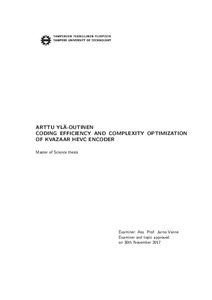Coding Efficiency and Complexity Optimization of Kvazaar HEVC Encoder
Ylä-Outinen, Arttu Matias (2018)
Ylä-Outinen, Arttu Matias
2018
Tietotekniikka
Tieto- ja sähkötekniikan tiedekunta - Faculty of Computing and Electrical Engineering
This publication is copyrighted. You may download, display and print it for Your own personal use. Commercial use is prohibited.
Hyväksymispäivämäärä
2018-08-15
Julkaisun pysyvä osoite on
https://urn.fi/URN:NBN:fi:tty-201806181989
https://urn.fi/URN:NBN:fi:tty-201806181989
Tiivistelmä
Growing video resolutions have led to an increasing volume of Internet video traffic, which has created a need for more efficient video compression. New video coding standards, such as High Efficiency Video Coding (HEVC), enable a higher level of compression, but the complexity of the corresponding encoder implementations is also higher. Therefore, encoders that are efficient in terms of both compression and complexity are required.
In this work, we implement four optimizations to Kvazaar HEVC encoder: 1) uniform inter and intra cost comparison; 2) concurrency-oriented SAO implementation; 3) resolution-adaptive thread allocation; and 4) fast cost estimation of coding coefficients. Optimization 1 changes the selection criterion of the prediction mode in fast configurations, which greatly improves the coding efficiency. Optimization 2 replaces the implementation of one of the in-loop filters with one that better supports concurrent processing. This allows removing some dependencies between encoding tasks, which provides more opportunities for parallel processing to increase coding speed. Optimization 3 reduces the overhead of thread management by spawning fewer threads when there is not enough work for all available threads. Optimization 4 speeds up the computation of residual coefficient coding costs by switching to a faster but less accurate estimation.
The impact of the optimizations is measured with two coding configurations of Kvazaar: the ultrafast preset, which aims for the fastest coding speed, and the veryslow preset, which aims for the best coding efficiency. Together, the introduced optimizations give a 2.8× speedup in the ultrafast configuration and a 3.4× speedup in the veryslow configuration. The trade-off for the speedup with the veryslow preset is a 0.15 % bit rate increase. However, with the ultrafast preset, the optimizations also improve coding efficiency by 14.39 %.
In this work, we implement four optimizations to Kvazaar HEVC encoder: 1) uniform inter and intra cost comparison; 2) concurrency-oriented SAO implementation; 3) resolution-adaptive thread allocation; and 4) fast cost estimation of coding coefficients. Optimization 1 changes the selection criterion of the prediction mode in fast configurations, which greatly improves the coding efficiency. Optimization 2 replaces the implementation of one of the in-loop filters with one that better supports concurrent processing. This allows removing some dependencies between encoding tasks, which provides more opportunities for parallel processing to increase coding speed. Optimization 3 reduces the overhead of thread management by spawning fewer threads when there is not enough work for all available threads. Optimization 4 speeds up the computation of residual coefficient coding costs by switching to a faster but less accurate estimation.
The impact of the optimizations is measured with two coding configurations of Kvazaar: the ultrafast preset, which aims for the fastest coding speed, and the veryslow preset, which aims for the best coding efficiency. Together, the introduced optimizations give a 2.8× speedup in the ultrafast configuration and a 3.4× speedup in the veryslow configuration. The trade-off for the speedup with the veryslow preset is a 0.15 % bit rate increase. However, with the ultrafast preset, the optimizations also improve coding efficiency by 14.39 %.
